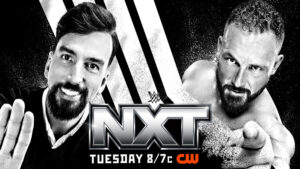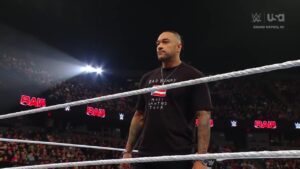It was a warm night in September of 1979, the World Wrestling Federation (WWF) in Rio de Janeiro, Brazil. Recently crowned WWF North American Heavyweight Champion Pat Patterson, who had defeated a pre-Million Dollar Man Ted DiBiase for the title that past June, was entered into a tournament to crown the new WWF South American Heavyweight Championship. By the end of the tournament, Patterson would hold both gold, unifying them as the true Americas champion, whose dominance was now intercontinental. Upon his return home, a new title was created, the WWF Intercontinental Championship, with Pat Patterson its initial victor. And thus, a 40-year history of a belt that has often been seen as the stepping stone to greatness, was born.
While history would eventually prove the majority of that legend to be false – there was no South American Heavyweight title and there was most definitely no tournament in Brazil – in a time before the internet, it was a tale that captivated naive wrestling fans around the world and introduced a new secondary title for the WWF (Pat Patterson would end up dropping the WWF North American title to NJPW’s Seiji Sakaguchi that November, before the title was finally abandoned in April of 1981). But with 1970’s star Pat Patterson holding the gold, the belt was immediately embraced as a new symbol of excellence in the WWF, and the second oldest active championship in the WWE behind the WWE World Championship (although the WWE United States Championship does indeed trace its lineage to the NWA United States title from 1975, although WWE only took possession in 2001).
The 1980s

The Intercontinental Championship was given a breath of “credibility” when it’s second champion emerged, in former US Olympian Ken Patera, who defeated Pat Patterson and held the title for 231 days. But for the first half of the 1980s, the IC title was dominated by a lengthy feud between former WWF World Champion Pedro Morales and Don Muraco. Between 1980 and 1984, the duo held the belt twice each, with Morales slightly beating Muraco with 619 days to Muraco’s 541. The two’s wars would set a precedent for hard work and tough battles, but Tito Santana‘s victory in 1984 brought in smaller wrestlers with more technical aspects, with the bigger muscle men heading to the main event to challenge Hulk Hogan instead. Sanata would feud with Greg “The Hammer” Valentine for two years, with Santana holding the belt twice (443 days) and Valentine once (285 days).
In 1986, Santana lost the belt to emerging Superstar “Macho Man” Randy Savage, who had come to the WWF as a huge free agent from the Southern territories. While he only held the belt once, it was for a staggering 414 days. Savage elevated the IC title like no champion before him, and his match against Ricky Steamboat at WrestleMania III in 1987 not only became a benchmark performance for the IC title, but for all of the WWF/E. Steamboat’s reign was short (he would return to the NWA shortly after his 65 day reign), but his successor, The Honky Tonk Man, would take the IC title to new heights as arguably the company’s top heel. With a record that stands to this day, the Honky Tonk Man held the IC title for a whopping 454 days.
The 1980s would end with the anointment of a new Superstar of the highest echelon in The Ultimate Warrior, who cemented his legacy quickly – he defeated the Honky Tonk Man for the belt in barely 30 seconds. For 216 days, Warrior’s stock rose and rose, as he ran through competition across the midcard, until he began feuding with “Ravishing” Rick Rude. Rude would capture the belt in early 1989, holding it for 148 days, before ultimately losing it back to his rival that August at SummerSlam. Warrior would hold the IC for the remainder of the decade, holding it into WrestleMania VI where he would defeat Hulk Hogan to hold the WWF World and Intercontinental Championship (although he would vacate the IC title shortly after). As the 1990s began, it would mark the end of the epic, slow paced storylines and title reigns that the 1980s would encompass, as a younger audience demanded faster action and new champions.
The 1990s

The 1990s began with a question mark for the IC title. After shifting to smaller, more technical grapplers like Santana, Savage and Steamboat, the 1980s ended with the muscle bound Ultimate Warrior dominating the title scene for the last two years of the decade. But the 1990s would see it return to its more technical side when former AWA World Champion Curt Hennig – now competing as Mr. Perfect – won the vacant title in April of 1990 in a tournament final against former champion Tito Santana. Perfect would hold it 126 days before dropping it to former NWA World Champion Kerry Von Erich. Perfect would reclaim it after a short reign by the “Texas Tornado” and hold it for a 280 days, establishing the IC title once again as the mastercraft title for future World Champion material. It was during his second reign where he began an epic feud against Bret “Hitman” Hart, culminating in a series of matches that many regard as the best feud of the IC title. At SummerSlam in 1991, Hart finally defeated Perfect, launching a singles career after a successful run in the WWF tag team division.
Bret Hart would hold the title twice in the next two years – with short breaks from The Mountie and Rowdy Roddy Piper – continuing Perfect’s emphasis on technical expertise and elevating the IC title to a potential main event championship. It lead to SummerSlam ’92, where he lost the title to his brother-in-law, “British Bulldog” Davey Boy Smith, in another classic IC match. Bulldog’s run inevitably proved to be more of a transitional (but popular) run and soon the IC became the next notch in the ascension of Shawn Michaels as a singles wrestler, defeating Bulldog in October of 1992 on Saturday Night’s Main Event. Michaels would hold it over 200 days – briefly trading it with former tag partner Marty Jannetty – before vacating the belt in the fall of 1993. During that empty time, former AWA and WCW star Scott Hall – now repackaged as Razor Ramon – would step up and become the next flag bearer for the IC title.
Ramon would become a symbol of the IC division for the next few years, capturing the belt on four occasions from 1993 to 1995 (at the time, the most decorated IC Champion). He would trade the belt with Diesel and Jeff Jarrett, and hold off a claim from Shawn Michaels – who claimed he never officially lost the IC strap in 1992 – with the legendary ladder match at WrestleMania X. Jeff Jarrett would also give Ramon a run for his money as the top star of the IC division, capturing the title three times in the first half of the 1990s.
The beginning of what would become the Attitude Era saw the enigmatic Goldust claim the IC title off of Ramon at the 1996 Royal Rumble – in many ways it was symbolic, as Ramon would depart the WWF soon after and head to rival WCW to help launch the Monday Night Wars, while Goldust’s bizarre character was indicative of WWF’s own headway into a more mature themed product as it began laying a foundation with Attitude. As the Monday Night Wars gained momentum, emerging new stars like Ahmed Johnson and Marc Mero would enter the mix, but it soon became an integral prop in the elevation of three stars – The Rock, Hunter Hearst Helmsley (Triple H) and “Stone Cold” Steve Austin – as the Attitude Era entered into full swing. Each man held the title twice each, often battling between themselves for the title, in wars that pushed all three to the main event. Owen Hart finally won IC gold – in a feud with Austin – and amidst the wars, Jarrett returned to win three more IC titles, to become the most decorated IC Champion with six. Other Attitude Era stars who captured the IC title included Val Venis, Ken Shamrock, The Godfather, D’Lo Brown, and a young Edge (who won it at a house show in Toronto and lost it the next night on Raw).
The 1990s ended with controversial fashion, as Chyna defeated Jeff Jarrett to become the first woman to win the Intercontinental Championship, who would go on to feud with a new star in the WWF Universe in former WCW star Chris Jericho. Following a double-pin draw between Jericho and Chyna in December of 1999, the IC title was vacated (although Jericho and Chyna acted as co-champions) and much like the previous decade, the Intercontinental title was now up in the air and ready for a new era.
The 2000s

Following the co-pin controversy, Chris Jericho became the undisputed IC Champion at the Royal Rumble in 2000, to start the decade as the new Intercontinental Champion. Jericho’s run over the next few years would see him battle the likes of Kurt Angle and Chris Benoit in classic matches, that resulted in Jericho being a three time champion by May of that year. Jericho would finish the decade with nine IC title reigns, setting a record that still stands to this day.
Unlike the previous two decades, the Intercontinental Championship would see few lengthy reigns. Chris Benoit would hold the title four times, with multiple reigns by emerging top stars like Rob Van Dam (6), Jeff Hardy (4), Edge (4), Christian (3), William Regal (2), Rey Mysterio (2), Umaga (2), John Morrison (2), and others, interspersed with runs by Ric Flair, Rikishi, Carlito, and CM Punk. A debuting Santino Marella won the IC title on his very first night – picked out of the crowd by Vince McMahon at a taping from Italy – and the longest reign of the decade was held by “The Gold Standard” Shelton Benjamin, who held the title for 245 days. Only Randy Orton‘s sole IC run of his career came close, at 210 days. While the 2000s had its share of classic IC confrontations, the sheer amount of title runs made the Intercontinental title feel diluted and in many cases felt like a throw away title and less prestigious than the two decades previous.

The 2010s

The year 2010 began with “The Chosen One” Drew McIntyre as the Intercontinental Champion, winning it at TLC the previous December. McIntyre would hold the title for 161 days before losing it to Kofi Kingston at Over The Limit that May. The decade would begin with WWE in a quest to elevate new stars, seeing the likes of Kingston, Dolph Ziggler, Wade Barrett, and Ezekiel Jackson capturing the gold.
But the IC title had lost a lot of the lustre it had acquired in its first two decades or so and was still viewed more as a consolation prize than the prestigious stepping stone of yore. But at Extreme Rules in 2012, Cody Rhodes wanted to change all that, when he defeated Ezekiel Jackson for the belt. The next night, he would return the IC belt design to the white leather strap, and hold the title for 234 days, still the longest reign of this past decade (and second longest, behind Benjamin’s 245, since Mr. Perfect’s 280-day reign in 1990). Rhodes reigned accomplished its feat and once again the IC title felt important, even if just a bit.
In July of 2012, The Miz would capture his first IC title – a year removed from being the WWE Champion at WrestleMania XXVII – starting a run that would see him capture the title on eight occasions in the next seven years. Sadly, the work that Cody Rhodes had put into his lengthy reign would soon be wasted, as the IC title became a hot potato once again, flopping between constant champs like Miz, Ziggler, and Barrett, mixed in with new stars like Big E, Luke Harper, Ryback, and Curtis Axel. It started to seem like the IC title was becoming more of a toy than a coveted prize.
At WrestleMania 31, a year removed from his epic triumph in capturing the WWE World title, Daniel Bryan won his first IC title, and it seemed like the title was back in good hands. But after only 43 days, it was vacated due to injury. But the momentum created by Daniel Bryan’s enthusiasm was infectious, and soon it found itself around the waist of top level talents like Kevin Owens, Dean Ambrose, Roman Reigns and Seth Rollins, once again becoming a top tier championship in the WWE.
The past year has seen it become a pivotal lynch pin reinvigorating the careers of Finn Balor and Bobby Lashley, and the recent July win from Shinsuke Nakamura at this year’s Extreme Rules – which saw Nakamura return to his Strong Style last seen in NXT – has once again put life into a championship that has appeared to be on life support for much of the past 20 years.
And this Sunday at Clash of Champions, Nakamura will put the belt on the line against The Miz, who will look to tie Chris Jericho with nine reigns as IC Champion, and only 21 days shy of breaking Pedro Morales record of 619 combined days as Intercontinental Champion. Here’s hoping that the next decade sees the Intercontinental title return to the prestige it has held in the past, and continues to elevate the brightest stars in the game to the Main Event.
Stay tuned to the Last Word on Pro Wrestling for more on this and other stories from around the world of wrestling, as they develop. You can always count on LWOPW to be on top of the major news in the wrestling world, as well as to provide you with analysis, previews, videos, interviews, and editorials on the wrestling world. Subscribe to the WWE Network to see all of WWE’s content.






